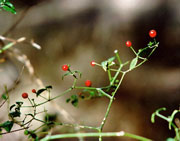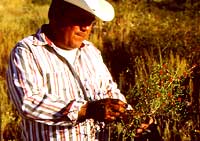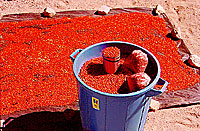A tongue-smoking red chili may stay out of hot water thanks to a new botanical area in Arizona, the first in the U.S. set aside to protect wild relatives of domesticated crops. The botanical area — a four-square-mile parcel in the Coronado National Forest, 50 miles south of Tucson — was officially dedicated to the preservation of the red-hot chiltepine last month.

Photo by Jesús García.
For more than 8,000 years, wild pea-sized chiltepines have grown in the Caribbean, Mexico, Peru, and the southwestern U.S. Now cattle grazing and fire threaten to eliminate the northernmost population of the chiltepines, a genetically hardy strain that has survived in a harsh climate along Arizona’s mountainous southern fringe. “The chiltepines that grow here may contain the genes for disease and pest resistance, or drought and frost tolerance,” says the botanical area’s project director, Suzanne Nelson of Native Seeds/SEARCH in Tucson, Ariz.
Special protection for chiltepine habitat is critical, Nelson says, because the plants have never been successfully harvested for more than three years in cultivated plots. Chiltepine plants grow under the shelter of nurse trees like mesquite, oak, and palmetto, which shield the chilis from sun, heat, frost, and nibblers like goats, cattle, and deer. The new botanical area’s high altitude, in addition to deterring some chili-munching animals, cuts down the chance of fire. Fire doesn’t harm the chilis directly, but it wreaks havoc on sensitive hackberries, a fruit-bearing nurse tree under which chilis like to grow.

Photo by Native Seeds/SEARCH.
Harvesters, or chiltepineros, pick an estimated 30 tons of chiltepines a year for salsa and stews, insect and bear sprays, and medicines to treat indigestion, arthritis, and mouth cancer. If we don’t protect the chiltepines in Arizona, “we could miss out on even more uses,” says Nelson.
The nonprofit Native Seeds/SEARCH — a seed conservation group that strives to protect the traditional farming methods of native peoples in the southwestern U.S. and northern Mexico — lobbied for creation of the wild chili botanical area. It struck up an agreement with the federal government that will let the group monitor the plant population, collect seeds, and conduct research on the land. The organization will also use the area as a training ground for natural resource managers from Mexico and elsewhere, building a network of people who can collaborate to solve common crop problems across international borders.

Photo by Josh Tewksbury.
Though there are between 2,000 and 3,000 domesticated varieties of chilis growing worldwide, chiltepines are one of only 23 wild species. “[Chiltepines] are the basis for virtually all the peppers we eat in this country,” says University of Montana chiltepine researcher Joshua Tewksbury. “Bell peppers, jalapeños, serranos, you name it — this little pepper is where they all came from.” Still, it’s the chiltepine’s heat that has earned it the moniker “the mother of all chilis.” The sinus-clearing power of this little firecracker makes it the third hottest chili in the world, behind only the habanero and Bahamian.
“Hell-fire in my mouth” is how 18th-century missionary Padre Ignaz Pfeffercorn, stationed near the present-day Arizona-Mexico border, described his introduction to chiltepines. “After the first mouthful the tears started to come,” Pfeffercorn said. “I could not say a word. However, one becomes accustomed to it after frequent bold victories, so that with time the dish becomes tolerable and finally very agreeable.”


